|

The NCR 8250 has evolved from a line of special-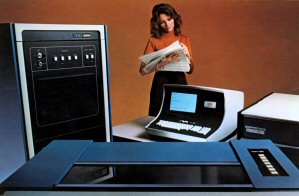 and general-purpose minicomputers that have proved their reliability and versatility during thousands of processing hours in virtually every type of business. Using the latest developments in hardware and software technology, NCR designers have produced a system that makes advanced data processing and file management techniques available to the small and medium-sized organization at a readily affordable cost, while offering the larger user a new avenue of approach to distributed processing. and general-purpose minicomputers that have proved their reliability and versatility during thousands of processing hours in virtually every type of business. Using the latest developments in hardware and software technology, NCR designers have produced a system that makes advanced data processing and file management techniques available to the small and medium-sized organization at a readily affordable cost, while offering the larger user a new avenue of approach to distributed processing.
The system is easy to understand and easy to operate, yet remarkably versatile. Despite its small physical size, it has the range and capacity to support multiprogramming, multiple online display terminals, and integrated data base processing. Up to 128,000 bytes of memory and 20 million bytes of disk storage can be housed in a single, compact highboy cabinet, together with the processor, an integrated magnetic tape cassette drive, and interfacing logic for peripherals and terminals.
Although specifically engineered to function as the core of interactive, transaction-driven applications, the 8250 is equally at home in batch and remote batch communication environments, where it readily handles jobs that are beyond the capacity of most other systems in its price range.
System Hardware
Processor
The NCR 8250 processor is a powerful, 16-bit word minicomputer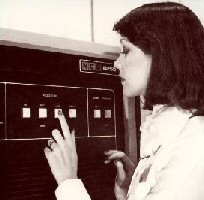 with a full repertoire of arithmetic, logic, and data transfer commands. The basic model has 48K bytes of MOS (metaloxide semi-conductor) memory, expandable in 16K-byte increments to a maximum of 128K bytes (64,000 words). Solid-state MOS memory was selected for the 8250 because of its inherently greater reliability and lower power consumption. with a full repertoire of arithmetic, logic, and data transfer commands. The basic model has 48K bytes of MOS (metaloxide semi-conductor) memory, expandable in 16K-byte increments to a maximum of 128K bytes (64,000 words). Solid-state MOS memory was selected for the 8250 because of its inherently greater reliability and lower power consumption.
Processor and memory are housed in a high-boy cabinet measuring 24 x 36 x 60 inches (609.60 x 914.40 x 1,542.00 mm). The cabinet can also contain one or two integrated magnetic tape cassette handlers and one or two integrated disk drives capable of storing up to 9.8 megabytes of data each. A basic system, including operator’s CRT and a matrix printer, occupies only 36 square feet of floor space. Because of this, and the equipment’s minimal environmental constraints, the NCR 8250 can be installed in most normal office locations with no extensive site preparation.
Disk Units
Additional disk units in various fixed/removable combinations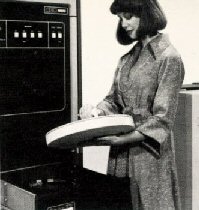 can be included in the system, providing a maximum of 80 million bytes of storage for large file applications. can be included in the system, providing a maximum of 80 million bytes of storage for large file applications.
As an option, the NCR 8250 is available with a second integrated disk controller. Dual controllers can provide better disk utilization and faster throughput by employing a hardware based seek overlap technique. Seek overlapping means that if two requests to access two different drives are on queue, one controller can position read/write heads to service the second request while the other controller is servicing the first, for maximum efficiency.
Magnetic Tape Handler and Flexible Disk
For those users who wish to employ magnetic tape for data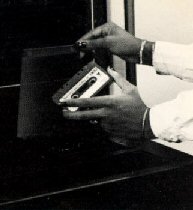 storage, the NCR 8250 can accommodate a handler for 9-channel tape recorded at either 800 bpi (NRZ mode) or 1600 bpi (phase mode) density. Transfer rate is either 10 or 20 kilobytes per second, depending upon recording density. storage, the NCR 8250 can accommodate a handler for 9-channel tape recorded at either 800 bpi (NRZ mode) or 1600 bpi (phase mode) density. Transfer rate is either 10 or 20 kilobytes per second, depending upon recording density.
Single and dual flexible disk drives are available for those users who wish to employ this medium for data interchange. Each single-surface flexible disk stores up to 242944 bytes of information. Data transfer rate is 38 kilobytes per second with a maximum access time of one second.
Display Terminals
Visual display terminals provide direct man/machine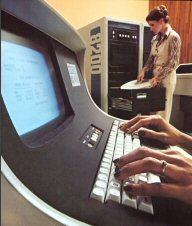 interface for rapid data entry and retrieval. Terminals have been specifically designed for ease of operation, with conveniently placed, typewriter-format keyboards comprising 64 upper-case alpha characters, digits, and symbols. A separate 10-key pad in standard calculator format simplifies entry of all-numeric data. interface for rapid data entry and retrieval. Terminals have been specifically designed for ease of operation, with conveniently placed, typewriter-format keyboards comprising 64 upper-case alpha characters, digits, and symbols. A separate 10-key pad in standard calculator format simplifies entry of all-numeric data.
Data is displayed as black characters against a white background with exceptional sharpness and definition. The terminal screen is 12 inches diagonally, and displays 24 lines of 80-character positions each.
The system can accommodate a maximum of seven local or remote CRT terminals, one of which is used as an operator’s console. Maximum baud rate for local terminals is 9600; for remote, 1200, because of carrier restrictions.
Printers
Several models of fully buffered printers are available to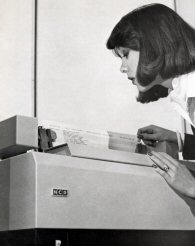 meet a wide range of reporting requirements. The base system printer is a 55 line/minute, matrix model that can print a continuous form original and up to four copies. The unit has a 64-character alphanumeric type set and prints a 132-column line at 10 characters per inch. Vertical spacing is six lines per inch, with form advance controlled by a combination of programming and a vertical format tape for maximum form-design flexibility. One printer can be located with the processor, and multiple matrix printers can be operated remotely as online output terminals. * meet a wide range of reporting requirements. The base system printer is a 55 line/minute, matrix model that can print a continuous form original and up to four copies. The unit has a 64-character alphanumeric type set and prints a 132-column line at 10 characters per inch. Vertical spacing is six lines per inch, with form advance controlled by a combination of programming and a vertical format tape for maximum form-design flexibility. One printer can be located with the processor, and multiple matrix printers can be operated remotely as online output terminals. *
Optional line printers having speeds up to 600 1pm are also available. Each model prints a 132- column line, has the same horizontal spacing as the matrix printer, and can produce an original and up to five copies.
*Each matrix printer used as a remote output terminal eliminates a position for a remote CAT. Printers used as CAT satellites do not.
System Software
IMOS III
The primary operating system for the NCR 8250 was IMOS III, a totally new system designed to serve as the basis for interactive, transaction-driven applications running in a multiprogramming environment. IMOS III includes many features that simplify operation, minimize software overhead, and ensure maximum system operating efficiency.
Shared application code and dynamic storage allocation for more efficient use of available memory.
Multiple applications running tinder IMOS III can share common modules of coding from a global pool rather than duplicating code for each job. Application space is assigned dynamically, as memory becomes available, rather than being fixed at the beginning of a job, for more efficient utilization of memory.
Terminal privilege assignment for greater system security.
IMOS III allows the user to assign any of three “privilege levels” to each terminal in the system. This ability provides a built-in safeguard against unauthorized use of certain system commands.
Operator lead-though to simplify start- of-day procedures.
At system startup, IMOS III presents the operator with a series of straightforward questions, which he answers in sequence to define such things as application mix, terminal and peripheral assignment, and terminal privilege levels. This approach greatly simplifies start-of- day procedures and guards against accidental entry of erroneous system parameters.
Enhanced object code and expanded command code to improve memory utilization.
System command code has been enhanced by the addition of new commands and the combining of certain existing commands for greater efficiency and flexibility. At the same time, changes in object code have resulted in reductions in memory requirements and an increase in processing speed.
Background job capability for more efficient use of processing time.
Any user-specified terminal in the system can initiate a background job to be run concurrently with its regular application processing, provided the background task does not require access to the terminal for output.
Other features include improvements in job initiation and overlay calling, dynamic alternate track allocation for disk files, and standardized input/output drivers that allow new peripherals to be added to an existing system without increasing memory requirements for executive software.
IMOS III was ideally suited to autotransaction processing systems, real-time, transaction-driven systems running in a multiprogramming environment to provide more flexibility, more features, and more information for every dollar invested.
Complete Software for Programs on Disc (SIN 10 / PIN 55) that we used:
- IMOS 02.16.00, March 1977: Master Software Cassette 1 & 2; Patch Cassette;
- C101 Simulator, Issue 5, 05.00.00; Master Software Cassette.
- STASHER;
- LOADRSC;
- CSBUILDR;
- MONITOR (D);
- REOCOPD;
- 656SORTD;
- RESTART.
Supplemental Software
In addition to IMOS III, the NCR 8250 has been also supported by operating systems for batch processing and bisynchronous remote batch communications. A most outstanding feature in a system of its size is the 8250’s ability to run a remote batch communication application concurrent with interactive or batch applications in a multiprogramming environment. This means that the system can be processing local work while at the same time communicating with a larger central system, making it an ideal choice for distributed processing networks.
Operating systems are supplemented by compilers for two high level programming languages, NCR COBOL 74 and NEAT/3, and by preprogrammed utility routines that perform functions common to most computer installations or frequently used during daily system operation.
General Specifications
Standard
- Processor: 16-bit word minicomputer
- Memory: Type: MOS; Size: 48K
- Peripherals:
- Disk: One integrated, single-spindle drive; one fixed, one removable platter with 5-megabyte capacity each
- Printer: 55 lpm matrix; 64-character type set; 132-column line(10 char/inch); 6 lines/inch vertical; Original plus 4 copies
- Cassette: Integrated, single-cassette drive; 800 bpi recording density
- CRT Display: 12-inch screen: 1,920 character screen capacity; 9,600 bps local; 1,200 bps remote transmission rates
Optional
- Memory: 128K-byte maximum in 16K-byte increments; Battery protect feature
- Peripherals:
- Disks: 80-megabyte maximum: Fixed and removable storage
- CRT Displays: Maximum of six additional: local or remote
- Matrix Printers: Maximum of six additional; if used as remote output terminals, each occupies one CRT position; if used as CRT satellite printers (screen contents only), number of CAT positions is not affected
- Line Printers: Up to 600 lpm
- Cassette: One additional integrated cassette handler
- Magnetic Tape: 9-channel; 800 bpi (NRZ) or 1600 bpi (Phase); 10 or 20 KB transfer rate, depending upon density
- Flexible Diskette: Single or dual drive; Single-surface diskette; 242,944 bytes
38 KB transfer rate
In Summary
The NCR 8250 brings new dimensions to minicomputer-based systems...
- Wide peripheral selection for maximum flexibility in system configuration
- Compact design and minimal environmental requirements for ease of installation
- Sophisticated software unusual in a system of its size
- Comprehensive, preprogrammed applications to simplify implementation
- Worldwide service and support as close as the nearest telephone
- Single source for all hardware, software, support and supplies, eliminating concern for the ability of individual vendors to meet commitments
- Inherent growth paths to protect the user’s initial investment
Related Links
Nifty New NCR Computer Model 8250 IMOS. Along With The 300lpm Printer And A 796-101 Monitor!
|

